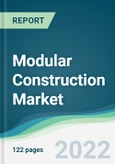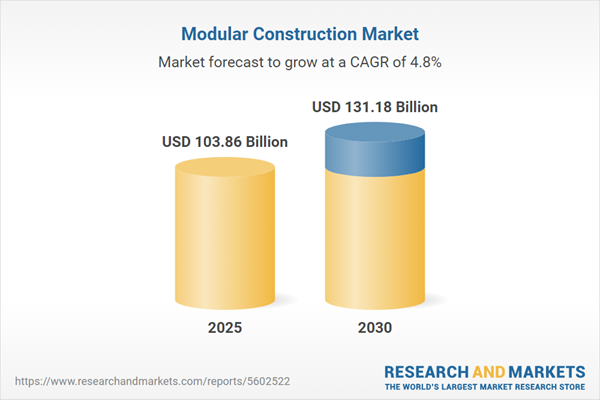The modular construction market is estimated to grow at a CAGR of 4.78% to attain US$131.182 billion in 2030 from US$103.864 billion in 2025.
Modular construction is a term used to describe the use of factory-produced pre-engineered building units that are delivered to the site and assembled as the elements of a building. Modular units are used for the construction of full or partial rooms or separate units such as lifts, toilets, etc. Modular construction is a less time-consuming process than the traditional construction process. It has several advantages over conventional construction, such as high flexibility, less pollution, improved air quality, less material waste, safe construction, advanced design opportunities, better-engineered buildings, etc. Growing construction activities in countries like China and India are expected to drive the market’s expansion. Furthermore, the cost-effectiveness of modular construction with fewer defects and reworks is expected to increase its demand and boost the overall market growth during the forecast period.
Modular construction is a term used to describe the use of factory-produced pre-engineered building units that are delivered to the site and assembled as the elements of a building. Modular units are used for the construction of full or partial rooms or separate units such as lifts, toilets, etc. Modular construction is a less time-consuming process than the traditional construction process. It has several advantages over conventional construction, such as high flexibility, less pollution, improved air quality, less material waste, safe construction, advanced design opportunities, better-engineered buildings, etc. Growing construction activities in countries like China and India are expected to drive the market’s expansion. Furthermore, the cost-effectiveness of modular construction with fewer defects and reworks is expected to increase its demand and boost the overall market growth during the forecast period.
Market Trends:
- Rising Construction Activities: Modular construction is gaining traction in the commercial sector due to its advantages, including lower maintenance and replacement costs throughout a building’s lifespan, energy-efficient designs, and enhanced occupant productivity. These commercial structures are built in compliance with the International Building Code (IBC) and state regulations, using durable, cost-effective, and recyclable materials. This has made modular construction increasingly popular for commercial projects, with developers globally investing billions into non-residential developments.
- Sustainability and Eco-Friendliness: The growing worldwide push for sustainable and environmentally friendly practices in construction is expected to drive the modular construction market’s expansion throughout the forecast period.
- Asia Pacific: The Asia Pacific region is projected to experience significant growth during the forecast period. Key drivers include government initiatives and policies in nations like India, China, and Vietnam, which focus on improving access to affordable housing. Additionally, rapid urbanization is a major factor boosting the demand for modular construction across the region.
Key Benefits of this Report:
- Insightful Analysis: Gain detailed market insights covering major as well as emerging geographical regions, focusing on customer segments, government policies and socio-economic factors, consumer preferences, industry verticals, and other sub-segments.
- Competitive Landscape: Understand the strategic maneuvers employed by key players globally to understand possible market penetration with the correct strategy.
- Market Drivers & Future Trends: Explore the dynamic factors and pivotal market trends and how they will shape future market developments.
- Actionable Recommendations: Utilize the insights to exercise strategic decisions to uncover new business streams and revenues in a dynamic environment.
- Caters to a Wide Audience: Beneficial and cost-effective for startups, research institutions, consultants, SMEs, and large enterprises.
What can businesses use this report for?
Industry and Market Insights, Opportunity Assessment, Product Demand Forecasting, Market Entry Strategy, Geographical Expansion, Capital Investment Decisions, Regulatory Framework & Implications, New Product Development, Competitive Intelligence.Report Coverage:
- Historical data from 2022 to 2024 & forecast data from 2025 to 2030
- Growth Opportunities, Challenges, Supply Chain Outlook, Regulatory Framework, and Trend Analysis
- Competitive Positioning, Strategies, and Market Share Analysis
- Revenue Growth and Forecast Assessment of segments and regions including countries
- Company Profiling (Strategies, Products, Financial Information, and Key Developments among others)
Modular Construction Market Segmentation:
By Type
- Permanent
- Relocatable
By Material
- Steel
- Precast Concrete
- Wood
- Plastic
- Others
By End-User
- Residential
- Commercial
- Industrial
By Region
- North America
- Europe
- Asia Pacific
- South America
- Middle East & Africa
Table of Contents
1. EXECUTIVE SUMMARY4. TECHNOLOGICAL OUTLOOK
2. MARKET SNAPSHOT
3. BUSINESS LANDSCAPE
5. MODULAR CONSTRUCTION MARKET BY TYPE
6. MODULAR CONSTRUCTION MARKET BY MATERIAL
7. MODULAR CONSTRUCTION MARKET BY END USER
8. MODULAR CONSTRUCTION MARKET BY GEOGRAPHY
9. COMPETITIVE ENVIRONMENT AND ANALYSIS
10. COMPANY PROFILES
11. APPENDIX
Companies Mentioned
- Laing O’Rourke
- Red Sea Housing
- ATCO
- Bouygues Construction
- VINCI
- Skanska AB
- Algeco Scotsman
- Lendlease Corporation
- KLEUSBERG GmbH & Co. KG
- Comfort Systems USA
- Clayton Homes
- Guerdon Modular Buildings
- Modular Building Systems
Methodology

LOADING...
Table Information
| Report Attribute | Details |
|---|---|
| No. of Pages | 142 |
| Published | March 2025 |
| Forecast Period | 2025 - 2030 |
| Estimated Market Value ( USD | $ 103.86 Billion |
| Forecasted Market Value ( USD | $ 131.18 Billion |
| Compound Annual Growth Rate | 4.7% |
| Regions Covered | Global |
| No. of Companies Mentioned | 13 |









